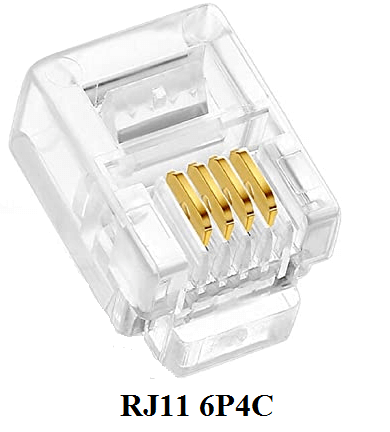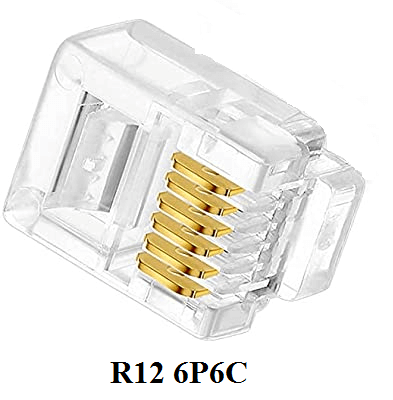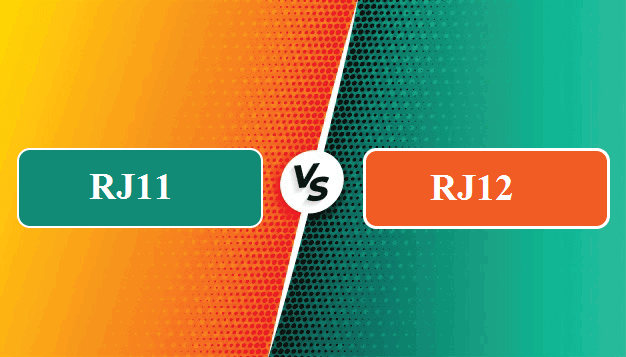Difference between RJ11 and RJ12Both RJ11 and RJ12 are telephone connections, and RJ11 and RJ12 are 6-pin and 8-pin connectors, respectively. In RJ11, only 4 wires are removed in the connector, whereas 6 wires are removed in the connector of RJ12. They serve different purposes, and it is critical to understand which one to utilize for the specific application. In this article, you will learn the difference between RJ11 and RJ12. But before discussing the differences, you must know about RJ11 and RJ12. What is RJ11 Connector?
Rj11 is an abbreviation for "Registered Jack 11". A connection jack makes a bridged connection for a single telephone line. The Rj11 connector jack is a non-digital mechanism, and RJ11 is a type of registered jack that is commonly utilized to connect telephone equipment. But, in terms of networking, RJ11 is even utilized to link a computer system to a LAN via the computer's modem. The RJ11 connector is a 6P4C connector with 6 positions and 4 contacts. As a result, the RJ11 cable has four copper wires linked to the center of the connecter, leaving the remaining two contacts unconnected. As a result, the RJ11 may link two telephone lines and one pair of cables for each. The RJ11 locks into place with a single locking tab which resembles the RJ-45 but is slightly smaller. However, it can be utilized to construct a LAN, the RJ45 connector is more commonly employed. What is RJ12 Connector?
Rj12 is an abbreviation for "Registered Jack 12". A connection jack connects a central telephone system to individual telephone lines via a line circuit. It is a male connector that only connects to the Rj12 female jack to form a connection. The Rj12 utilizes a 6P6C connector, and it contains 6 connection slots, all of which are utilized for communication. RJ12 connectors are connected using specialized RJ12 6-flat ribbon standard cables. This cable is made up of six thin copper cables that send and receive electrical signals. All six copper conductors in this conventional ribbon cable are color labeled, and white, black, red, green, yellow, and blue are the colors. Unlike previous wearing systems, the Rj12 is completely unique and complex. To make the copper-wearing system functional, the cable technician must place it in the proper order. Since numerous corporate offices needed a centralized telephone network for private usage in the 1980s, the Rj12 connector became popular. This connector makes it easy to set up a local area network with telephones in the office. Even in this digital time, many organizations still utilize this connector to connect their intercom system. However, both connectors are utilized for telephone lines, some other apps, including keyed telephone systems and PBXs, make use of the additional two connectors. Key differences between RJ11 Connector and RJ12 Connector
There are various key differences between RJ11 and RJ12. Some main differences between the RJ11 and RJ12 are as follows:
Head-to-head comparison between RJ11 and RJ12Here, you will learn the head-to-head comparisons between RJ11 and RJ12. The main differences between RJ11 and RJ12 are as follows:
ConclusionIn summary, RJ11 and RJ12 connections are two of the most prevalent jacks used in telecommunications and networking. Although they appear the same, they have significant distinctions affecting their applications. Understanding the distinctions between the two connectors is critical in selecting the best one for your operation. Choosing a suitable option tailored to your needs is important by knowing their sizes, applications, usability, designs, pin configurations, terminal layouts, performance, and pricing. Having the appropriate connector makes or breaks a successful installation. RJ11 and RJ12 are typical telephone line connectors that use the same six-slot connection, and the main distinction between them is their wiring layout. RJ11 only utilizes 4 of the 6 available slots, but RJ12 uses all six. However, RJ12 is less widespread than RJ11 today since RJ11 can be found in homes connecting modems and telephone lines. In contrast, major corporations only utilize RJ12 to link telephones to the centralized telephone network.
Next TopicDifference between
|
 For Videos Join Our Youtube Channel: Join Now
For Videos Join Our Youtube Channel: Join Now
Feedback
- Send your Feedback to [email protected]
Help Others, Please Share










